The Application of Artificial Intelligence and Big Data in the Food Industry
Abstract
:1. Introduction
1.1. The Early Situation in the Food Industry
1.2. The Current State of the Food Industry
1.3. The Importance of Food Safety
1.4. Digital Transformation in the Food Industry
2. Big Data in the Food Industry
2.1. Applications of Big Data in the Food Industry
2.1.1. Application of Personalized Marketing and Recommendation System
2.1.2. Consumer Behavior Analysis and Forecasting
2.1.3. The Utilization of Big Data Analytics in Supply Chain Management
2.1.4. Application of Forecasting Models and Machine Learning Algorithms in Demand Forecasting
2.2. The Bottleneck of Big Data Applications for the Food Industry
2.3. Blockchain Technology
3. Artificial Intelligence in the Food Sector
3.1. Knowledge-Based Expert Systems in the Food Industry
The Future and Challenges of Expert Systems
3.2. Fuzzy Logic Systems
3.3. Adaptive Neuro-Fuzzy Inference System (ANFIS) Technology
3.4. Near-Infrared Spectroscopy Technology Combined with Artificial Intelligence
3.5. Application of Computer Vision Systems in the Food Industry
3.6. Artificial Intelligence Combined with Smart Sensors for Real-Time Inspection in the Food Industry
4. Future Trends and Challenges for Artificial Intelligence Applications in the Food Field
4.1. Future Development Direction and Outlook
4.1.1. Application Prospects of Emerging Technologies
4.1.2. Possible Directions for Innovation and Improvement
4.1.3. Exploration of Feasibility and Sustainability Issues
4.1.4. Future Challenges Ahead
5. Conclusions
Author Contributions
Funding
Institutional Review Board Statement
Informed Consent Statement
Data Availability Statement
Acknowledgments
Conflicts of Interest
References
- Akoka, J.; Comyn-Wattiau, I.; Laoufi, N. Research on Big Data—A systematic mapping study. Comput. Stand. Interfaces 2017, 54, 105–115. [Google Scholar] [CrossRef]
- Schroeder, R. Big data business models: Challenges and opportunities. Cogent Soc. Sci. 2016, 2, 1166924. [Google Scholar] [CrossRef]
- Misra, N.; Dixit, Y.; Al-Mallahi, A.; Bhullar, M.S.; Upadhyay, R.; Martynenko, A. IoT, big data, and artificial intelligence in agriculture and food industry. IEEE Int. Things J. 2020, 9, 6305–6324. [Google Scholar] [CrossRef]
- Sahu, M.; Gupta, R.; Ambasta, R.K.; Kumar, P. Artificial intelligence and machine learning in precision medicine: A paradigm shift in big data analysis. Prog. Mol. Biol. Transl. Sci. 2022, 190, 57–100. [Google Scholar] [CrossRef] [PubMed]
- Ramakrishna, R.R.; Abd Hamid, Z.; Zaki, W.M.D.W.; Huddin, A.B.; Mathialagan, R. Stem cell imaging through convolutional neural networks: Current issues and future directions in artificial intelligence technology. PeerJ 2020, 8, e10346. [Google Scholar] [CrossRef] [PubMed]
- Serazetdinova, L.; Garratt, J.; Baylis, A.; Stergiadis, S.; Collison, M.; Davis, S. How should we turn data into decisions in AgriFood? J. Sci. Food Agric. 2019, 99, 3213–3219. [Google Scholar] [CrossRef] [PubMed]
- Ben Ayed, R.; Hanana, M. Artificial Intelligence to Improve the Food and Agriculture Sector. J. Food Qual. 2021, 2021, 7. [Google Scholar] [CrossRef]
- Corney, D. Food bytes: Intelligent systems in the food industry. Br. Food J. 2002, 104, 787–805. [Google Scholar] [CrossRef]
- Qian, C.; Murphy, S.; Orsi, R.; Wiedmann, M. How can AI help improve food safety? Annu. Rev. Food Sci. Technol. 2023, 14, 517–538. [Google Scholar] [CrossRef]
- Camarena, S. Artificial intelligence in the design of the transitions to sustainable food systems. J. Clean. Prod. 2020, 271, 122574. [Google Scholar] [CrossRef]
- Mavani, N.R.; Ali, J.M.; Othman, S.; Hussain, M.; Hashim, H.; Rahman, N.A. Application of artificial intelligence in food industry—A guideline. Food Eng. Rev. 2022, 14, 134–175. [Google Scholar] [CrossRef]
- Brookes, B.C. Theory of the Bradford law. J. Doc. 1977, 33, 180–209. [Google Scholar] [CrossRef]
- Kumar, M.V.; Iyengar, N.C.S. A framework for Blockchain technology in rice supply chain management. Adv. Sci. Technol. Lett. 2017, 146, 125–130. [Google Scholar] [CrossRef]
- Zhong, R.; Xu, X.; Wang, L. Food supply chain management: Systems, implementations, and future research. Ind. Manag. Data Syst. 2017, 117, 2085–2114. [Google Scholar] [CrossRef]
- Jagtap, S.; Bader, F.; Garcia-Garcia, G.; Trollman, H.; Fadiji, T.; Salonitis, K. Food logistics 4.0: Opportunities and challenges. Logistics 2020, 5, 2. [Google Scholar] [CrossRef]
- van Asselt, E.D.; Van der Fels-Klerx, H.; Marvin, H.; Van Bokhorst-van de Veen, H.; Groot, M.N. Overview of food safety hazards in the European dairy supply chain. Compr. Rev. Food Sci. Food Saf. 2017, 16, 59–75. [Google Scholar] [CrossRef]
- Aung, M.M.; Chang, Y.S. Traceability in a food supply chain: Safety and quality perspectives. Food Control 2014, 39, 172–184. [Google Scholar] [CrossRef]
- Fung, F.; Wang, H.S.; Menon, S. Food safety in the 21st century. Biomed. J. 2018, 41, 88–95. [Google Scholar] [CrossRef]
- Janjarasskul, T.; Suppakul, P. Active and intelligent packaging: The indication of quality and safety. Crit. Rev. Food Sci. Nutr. 2018, 58, 808–831. [Google Scholar] [CrossRef]
- Chen, K.; Tan, H.; Gao, J.; Lu, Y. Big data based design of food safety cloud platform. Appl. Mech. Mater. 2014, 536, 583–587. [Google Scholar] [CrossRef]
- Hassoun, A.; Jagtap, S.; Garcia-Garcia, G.; Trollman, H.; Pateiro, M.; Lorenzo, J.M.; Trif, M.; Rusu, A.V.; Aadil, R.M.; Simat, V.; et al. Food quality 4.0: From traditional approaches to digitalized automated analysis. J. Food Eng. 2023, 337, 16. [Google Scholar] [CrossRef]
- Aguilar, E.; Bolaños, M.; Radeva, P. Exploring food detection using CNNs. In Proceedings of the Computer Aided Systems Theory–EUROCAST 2017: 16th International Conference, Las Palmas de Gran Canaria, Spain, 19–24 February 2017; Revised Selected Papers, Part II 16. Springer: Berlin/Heidelberg, Germany, 2018; pp. 339–347. [Google Scholar]
- Ding, H.; Wilson, D.I.; Yu, W.; Young, B.R. An investigation of the relative impact of process and shape factor variables on milk powder quality. Food Bioprod. Process. 2021, 126, 62–72. [Google Scholar] [CrossRef]
- Ding, H.; Wilson, D.I.; Yu, W.; Young, B.R. Assessing and Quantifying the Surface Texture of Milk Powder Using Image Processing. Foods 2022, 11, 1519. [Google Scholar] [CrossRef] [PubMed]
- Ding, H.; Wilson, D.I.; Yu, W.; Young, B.R.; Cui, X. Application of Three-Dimensional Digital Photogrammetry to Quantify the Surface Roughness of Milk Powder. Foods 2023, 12, 967. [Google Scholar] [CrossRef] [PubMed]
- Zhong, J.; Sun, L.; Zuo, E.; Chen, C.; Chen, C.; Jiang, H.; Li, H.; Lv, X. An ensemble of AHP-EW and AE-RNN for food safety risk early warning. PLoS ONE 2023, 18, e0284144. [Google Scholar] [CrossRef] [PubMed]
- Do, H.-D.; Kim, D.-E.; Lam, M.B.; Chung, W.-Y. Self-powered food assessment system using LSTM network and 915 MHz RF energy harvesting. IEEE Access 2021, 9, 97444–97456. [Google Scholar] [CrossRef]
- Dayıoğlu, M.A.; Turker, U. Digital transformation for sustainable future-agriculture 4.0: A review. J. Agric. Sci. 2021, 27, 373–399. [Google Scholar] [CrossRef]
- Chen, J.; Chen, Y.; Du, X.; Li, C.; Lu, J.; Zhao, S.; Zhou, X. Big data challenge: A data management perspective. Front. Comput. Sci. 2013, 7, 157–164. [Google Scholar] [CrossRef]
- Li, Z.-H.; Wang, G.-R.; Zhou, A.-Y. Research progress and trends of big data from a database perspective. Comput. Eng. Sci./Jisuanji Gongcheng Yu Kexue 2013, 35, 19–30. [Google Scholar] [CrossRef]
- Mohamed, A.; Najafabadi, M.K.; Wah, Y.B.; Zaman, E.A.K.; Maskat, R. The state of the art and taxonomy of big data analytics: View from new big data framework. Artif. Intell. Rev. 2020, 53, 989–1037. [Google Scholar] [CrossRef]
- Géczy, P. Big data characteristics. Macrotheme Rev. 2014, 3, 94–104. [Google Scholar] [CrossRef]
- Sravanthi, K.; Reddy, T.S. Applications of big data in various fields. Int. J. Comput. Sci. Inf. Technol. 2015, 6, 4629–4632. [Google Scholar] [CrossRef]
- Du, X.; Lu, W.; Zhang, F. History, Present, and Future of Big Data Management Systems. J. Softw. 2019, 30, 127–141. [Google Scholar] [CrossRef]
- Torre-Bastida, A.I.; Del Ser, J.; Lana, I.; Ilardia, M.; Bilbao, M.N.; Campos-Cordobes, S. Big Data for transportation and mobility: Recent advances, trends and challenges. Iet Intell. Transp. Syst. 2018, 12, 742–755. [Google Scholar] [CrossRef]
- Chen, J.; Ding, Z.; Gao, X. Survey of Big Data Hot Techniques. J. Beijing Univ. Technol. 2017, 43, 358–367. [Google Scholar] [CrossRef]
- Guo, P.; Wang, K.; Luo, A.; Xue, M. Computational Intelligence for Big Data Analysis: Current Status and Future Prospect. J. Softw. 2015, 26, 3010–3025. [Google Scholar] [CrossRef]
- Zuheros, C.; Martínez-Cámara, E.; Herrera-Viedma, E.; Herrera, F. Sentiment analysis based multi-person multi-criteria decision making methodology using natural language processing and deep learning for smarter decision aid. Case study of restaurant choice using TripAdvisor reviews. Inf. Fusion 2021, 68, 22–36. [Google Scholar] [CrossRef]
- Delanoy, N.; Kasztelnik, K. Business Open Big Data Analytics to Support Innovative Leadership Decision in Canada. Bus. Ethics Leadersh. 2020, 4, 56–74. [Google Scholar] [CrossRef]
- Zhou, Q.; Zhang, H.; Wang, S. Artificial intelligence, big data, and blockchain in food safety. Int. J. Food Eng. 2021, 18, 1–14. [Google Scholar] [CrossRef]
- Li, W.; Gu, C.; Chen, J.; Ma, C.; Zhang, X.; Chen, B.; Wan, S. DLS-GAN: Generative Adversarial Nets for Defect Location Sensitive Data Augmentation. IEEE Trans. Autom. Sci. Eng. 2023, 33, 1–17. [Google Scholar] [CrossRef]
- Ding, H.; Li, B.; Boiarkina, I.; Wilson, D.I.; Yu, W.; Young, B.R. Effects of morphology on the bulk density of instant whole milk powder. Foods 2020, 9, 1024. [Google Scholar] [CrossRef] [PubMed]
- Ding, H.; Yu, W.; Boiarkina, I.; Depree, N.; Young, B.R. Effects of morphology on the dispersibility of instant whole milk powder. J. Food Eng. 2020, 276, 109841. [Google Scholar] [CrossRef]
- Schakel, S.F.; Buzzard, I.M.; Gebhardt, S.E. Procedures for estimating nutrient values for food composition databases. J. Food Compos. Anal. 1997, 10, 102–114. [Google Scholar] [CrossRef]
- Marvin, H.J.; Janssen, E.M.; Bouzembrak, Y.; Hendriksen, P.J.; Staats, M. Big data in food safety: An overview. Crit. Rev. Food Sci. Nutr. 2017, 57, 2286–2295. [Google Scholar] [CrossRef] [PubMed]
- Kazama, M.; Sugimoto, M.; Hosokawa, C.; Matsushima, K.; Varshney, L.R.; Ishikawa, Y. A neural network system for transformation of regional cuisine style. Front. ICT 2018, 5, 14. [Google Scholar] [CrossRef]
- Kalra, J.; Batra, D.; Diwan, N.; Bagler, G. Nutritional profile estimation in cooking recipes. In Proceedings of the 2020 IEEE 36th International Conference on Data Engineering Workshops (ICDEW), Dallas, TX, USA, 14–20 April 2020; IEEE: Piscataway, NJ, USA, 2020; pp. 82–87. [Google Scholar]
- Whitehouse, S.; Yordanova, K.; Paiement, A.; Mirmehdi, M. Recognition of unscripted kitchen activities and eating behaviour for health monitoring. In Proceedings of the 2nd IET International Conference on Technologies for Active and Assisted Living (TechAAL 2016), London, UK, 24–25 October 2016; IET: London, UK, 2016; pp. 1–6. [Google Scholar]
- Lee, M.; Kwon, W.; Back, K.-J. Artificial intelligence for hospitality big data analytics: Developing a prediction model of restaurant review helpfulness for customer decision-making. Int. J. Contemp. Hosp. Manag. 2021, 33, 2117–2136. [Google Scholar] [CrossRef]
- Maru, A.; Berne, D.; De Beer, J.; Ballantyne, P.; Pesce, V.; Kalyesubula, S.; Fourie, N.; Addison, C.; Collett, A.; Chaves, J. Digital and data-driven agriculture: Harnessing the power of data for smallholders. F1000Research 2018, 7, 525. [Google Scholar] [CrossRef]
- Kamble, S.S.; Gunasekaran, A.; Gawankar, S.A. Achieving sustainable performance in a data-driven agriculture supply chain: A review for research and applications. Int. J. Prod. Econ. 2020, 219, 179–194. [Google Scholar] [CrossRef]
- Liao, S.-H.; Yang, C.-A. Big data analytics of social network marketing and personalized recommendations. Soc. Netw. Anal. Min. 2021, 11, 1–19. [Google Scholar] [CrossRef]
- Mariani, M.M.; Wamba, S.F. Exploring how consumer goods companies innovate in the digital age: The role of big data analytics companies. J. Bus. Res. 2020, 121, 338–352. [Google Scholar] [CrossRef]
- Verma, J.P.; Patel, B.; Patel, A. Big data analysis: Recommendation system with Hadoop framework. In Proceedings of the 2015 IEEE International Conference on Computational Intelligence & Communication Technology, Ghaziabad, India, 13–14 February 2015; IEEE: Piscataway, NJ, USA, 2015; pp. 92–97. [Google Scholar]
- Le, T.M.; Liaw, S.-Y. Effects of pros and cons of applying big data analytics to consumers’ responses in an e-commerce context. Sustainability 2017, 9, 798. [Google Scholar] [CrossRef]
- Ji, G.; Hu, L.; Tan, K.H. A study on decision-making of food supply chain based on big data. J. Syst. Sci. Syst. Eng. 2017, 26, 183–198. [Google Scholar] [CrossRef]
- Rabl, T.; Sadoghi, M.; Jacobsen, H.-A.; Gómez-Villamor, S.; Muntés-Mulero, V.; Mankowskii, S. Solving big data challenges for enterprise application performance management. arXiv 2012, arXiv:1208.4167. [Google Scholar] [CrossRef]
- Joshi, A.; Khosravy, M.; Gupta, N. Machine learning for predictive analysis. Proc. ICTIS 2020, 13, 225. [Google Scholar] [CrossRef]
- Cheng, Y.; Chen, K.; Sun, H.; Zhang, Y.; Tao, F. Data and knowledge mining with big data towards smart production. J. Ind. Inf. Integr. 2018, 9, 1–13. [Google Scholar] [CrossRef]
- Hofmann, E.; Rutschmann, E. Big data analytics and demand forecasting in supply chains: A conceptual analysis. Int. J. Logist. Manag. 2018, 29, 739–766. [Google Scholar] [CrossRef]
- Djekic, I.; Sanjuán, N.; Clemente, G.; Jambrak, A.R.; Tonda, A. Review on environmental models in the food chain-Current status and future perspectives. J. Clean. Prod. 2018, 176, 1012–1025. [Google Scholar] [CrossRef]
- Bronson, K.; Knezevic, I. Big Data in food and agriculture. Big Data Soc. 2016, 3, 2053951716648174. [Google Scholar] [CrossRef]
- Ducange, P.; Pecori, R.; Mezzina, P. A glimpse on big data analytics in the framework of marketing strategies. Soft Comput. 2018, 22, 325–342. [Google Scholar] [CrossRef]
- Mehmood, A.; Natgunanathan, I.; Xiang, Y.; Hua, G.; Guo, S. Protection of big data privacy. IEEE Access 2016, 4, 1821–1834. [Google Scholar] [CrossRef]
- Deepa, N.; Pham, Q.-V.; Nguyen, D.C. A survey on blockchain for big data: Approaches, opportunities, and future directions. Future Gener. Comput. Syst. 2022, 131, 209–226. [Google Scholar] [CrossRef]
- Khan, S.N.; Loukil, F.; Ghedira-Guegan, C.; Benkhelifa, E.; Bani-Hani, A. Blockchain smart contracts: Applications, challenges, and future trends. Peer–Peer Netw. Appl. 2021, 14, 2901–2925. [Google Scholar] [CrossRef] [PubMed]
- Puthal, D.; Malik, N.; Mohanty, S.P.; Kougianos, E.; Yang, C. The blockchain as a decentralized security framework [future directions]. IEEE Consum. Electron. Mag. 2018, 7, 18–21. [Google Scholar] [CrossRef]
- De Filippi, P. The interplay between decentralization and privacy: The case of blockchain technologies. J. Peer Prod. Issue 2016, 14, 508–527. [Google Scholar]
- Macrinici, D.; Cartofeanu, C.; Gao, S. Smart contract applications within blockchain technology: A systematic mapping study. Telemat. Inform. 2018, 35, 2337–2354. [Google Scholar] [CrossRef]
- Ahmed, S.; ten Broek, N. Blockchain could boost food security. Nature 2017, 550, 43. [Google Scholar] [CrossRef]
- Feng, H.; Wang, X.; Duan, Y.Q.; Zhang, J.; Zhang, X.S. Applying blockchain technology to improve agri-food traceability: A review of development methods, benefits and challenges. J. Clean. Prod. 2020, 260, 15. [Google Scholar] [CrossRef]
- Jaison, F.; Ramaiah, N.S. A survey on traceability in food safety system using blockchain. J. Discret. Math. Sci. Cryptogr. 2022, 25, 793–799. [Google Scholar] [CrossRef]
- Kim, H.M.; Laskowski, M. Toward an ontology-driven blockchain design for supply-chain provenance. Intell. Syst. Account. Financ. Manag. 2018, 25, 18–27. [Google Scholar] [CrossRef]
- Demestichas, K.; Peppes, N.; Alexakis, T.; Adamopoulou, E. Blockchain in Agriculture Traceability Systems: A Review. Appl. Sci. 2020, 10, 4113. [Google Scholar] [CrossRef]
- Lin, Q.; Wang, H.; Pei, X.; Wang, J. Food safety traceability system based on blockchain and EPCIS. IEEE Access 2019, 7, 20698–20707. [Google Scholar] [CrossRef]
- Mohan, T. Improve Food Supply Chain Traceability Using Blockchain. Master’s Thesis, The Pennsylvania State University, State College, PA, USA, 2018. [Google Scholar]
- Mao, D.H.; Hao, Z.H.; Wang, F.; Li, H.S. Innovative Blockchain-Based Approach for Sustainable and Credible Environment in Food Trade: A Case Study in Shandong Province, China. Sustainability 2018, 10, 3149. [Google Scholar] [CrossRef]
- Smith, B.G. Developing sustainable food supply chains. Philos. Trans. R. Soc. B-Biol. Sci. 2008, 363, 849–861. [Google Scholar] [CrossRef] [PubMed]
- Ariemma, L.; De Carlo, N.; Pennino, D.; Pizzonia, M.; Vitaletti, A.; Zecchini, M. Blockchain for the supply chain of the Italian craft beer sector: Tracking and discount coupons. Int. J. Parallel Emergent Distrib. Syst. 2023, 16, 1–34. [Google Scholar] [CrossRef]
- Cao, S.; Powell, W.; Foth, M.; Natanelov, V.; Miller, T.; Dulleck, U. Strengthening consumer trust in beef supply chain traceability with a blockchain-based human-machine reconcile mechanism. Comput. Electron. Agric. 2021, 180, 105886. [Google Scholar] [CrossRef]
- Lucena, P.; Binotto, A.P.; Momo, F.d.S.; Kim, H. A case study for grain quality assurance tracking based on a Blockchain business network. arXiv 2018, arXiv:1803.07877. [Google Scholar] [CrossRef]
- Kshetri, N. Blockchain and the economics of food safety. It Prof. 2019, 21, 63–66. [Google Scholar] [CrossRef]
- Bai, C.; Sarkis, J. A supply chain transparency and sustainability technology appraisal model for blockchain technology. Int. J. Prod. Res. 2020, 58, 2142–2162. [Google Scholar] [CrossRef]
- Zheng, Z.; Xie, S.; Dai, H.-N.; Chen, X.; Wang, H. Blockchain challenges and opportunities: A survey. Int. J. Web Grid Serv. 2018, 14, 352–375. [Google Scholar] [CrossRef]
- Marvin, H.J.; Bouzembrak, Y.; Van der Fels-Klerx, H. Digitalisation and Artificial Intelligence for sustainable food systems. Trends Food Sci. Technol. 2022, 120, 344–348. [Google Scholar] [CrossRef]
- Li, W.; Chen, J.; Cao, J.; Ma, C.; Wang, J.; Cui, X.; Chen, P. EID-GAN: Generative adversarial nets for extremely imbalanced data augmentation. IEEE Transac. Ind. Inform. 2022, 19, 3208–3218. [Google Scholar] [CrossRef]
- Kaula, R.; Lander, L.C. A Module-Based Conceptual-Framework For Large-Scale Expert-Systems. Ind. Manag. Data Syst. 1995, 95, 15–23. [Google Scholar] [CrossRef]
- Yang, X.; Zhu, D.-Q.; Sang, Q.-B. Research and prospect of expert system. Jisuanji Yingyong Yanjiu/Appl. Res. Comput. 2007, 24, 4–9. [Google Scholar] [CrossRef]
- Valavanis, K.P.; Kokkinaki, A.I.; Tzafestas, S.G. Knowledge-Based (Expert) Systems In Engineering Applications—A Survey. J. Intell. Robot. Syst. 1994, 10, 113–145. [Google Scholar] [CrossRef]
- Myers, W. Introduction to expert systems. IEEE Intell. Syst. 1986, 1, 100–109. [Google Scholar] [CrossRef]
- Filter, M.; Appel, B.; Buschulte, A. Expert systems for food safety. Curr. Opin. Food Sci. 2015, 6, 61–65. [Google Scholar] [CrossRef]
- Vasquez, R.P.; Aguilar-Lasserre, A.A.; Lopez-Segura, M.V.; Rivero, L.C.; Rodriguez-Duran, A.A.; Rojas-Luna, M.A. Expert system based on a fuzzy logic model for the analysis of the sustainable livestock production dynamic system. Comput. Electron. Agric. 2019, 161, 104–120. [Google Scholar] [CrossRef]
- Blagoveshchenskiy, I.; Blagoveshchenskiy, V.; Besfamilnaya, E.; Sumerin, V. Development of databases of intelligent expert systems for automatic control of product quality indicators. In Journal of Physics: Conference Series; IOP Publishing: Bristol, UK, 2020; p. 012019. [Google Scholar]
- Hernández-Vera, B.; Aguilar Lasserre, A.A.; Gastón Cedillo-Campos, M.; Herrera-Franco, L.E.; Ochoa-Robles, J. Expert system based on fuzzy logic to define the production process in the coffee industry. J. Food Process Eng. 2017, 40, e12389. [Google Scholar] [CrossRef]
- Saibene, A.; Assale, M.; Giltri, M. Expert systems: Definitions, advantages and issues in medical field applications. Expert Syst. Appl. 2021, 177, 114900. [Google Scholar] [CrossRef]
- Wagner, W.P. Trends in expert system development: A longitudinal content analysis of over thirty years of expert system case studies. Expert Syst. Appl. 2017, 76, 85–96. [Google Scholar] [CrossRef]
- Castillo, O.; Amador-Angulo, L.; Castro, J.R.; Garcia-Valdez, M. A comparative study of type-1 fuzzy logic systems, interval type-2 fuzzy logic systems and generalized type-2 fuzzy logic systems in control problems. Inf. Sci. 2016, 354, 257–274. [Google Scholar] [CrossRef]
- Eerikainen, T.; Linko, P.; Linko, S.; Siimes, T.; Zhu, Y.-H. Fuzzy-Logic and Neural-Network Applications In Food-Science And Technology. Trends Food Sci. Technol. 1993, 4, 237–242. [Google Scholar] [CrossRef]
- Li, H. Output-back fuzzy logic systems and equivalence with feedback neural networks. Chin. Sci. Bull. 2000, 45, 592–596. [Google Scholar] [CrossRef]
- Farzaneh, V.; Ghodsvali, A.; Bakhshabadi, H.; Ganje, M.; Dolatabadi, Z.; Carvalho, I.S. Modelling of the Selected Physical Properties of the Fava Bean with Various Moisture Contents UsingFuzzy Logic Design. J. Food Process Eng. 2017, 40, 9. [Google Scholar] [CrossRef]
- Zadeh, L.A. The calculus of fuzzy if-then rules. In Proceedings of the Fuzzy Engineering toward Human Friendly Systems—Proceedings of the International Fuzzy Engineering Symposium, Leipzig, Germany, 20–22 September 2023; pp. 11–12. [Google Scholar]
- Mahadevappa, J.; Gross, F.; Delgado, A. Fuzzy logic based process control strategy for effective sheeting of wheat dough in small and medium-sized enterprises. J. Food Eng. 2017, 199, 93–99. [Google Scholar] [CrossRef]
- Tanima, C.; Madhusweta, D. Sensory evaluation of aromatic foods packed in developed starch based films using fuzzy logic. Int. J. Food Stud. 2015, 4, 29–48. [Google Scholar] [CrossRef]
- Farzaneh, V.; Bakhshabadi, H.; Gharekhani, M.; Ganje, M.; Farzaneh, F.; Rashidzadeh, S.; Carvalho, I.S. Application of an adaptive neuro_fuzzy inference system (ANFIS) in the modeling of rapeseeds’ oil extraction. J. Food Process Eng. 2017, 40, 8. [Google Scholar] [CrossRef]
- Samodro, B.; Mahesworo, B.; Suparyanto, T.; Atmaja, D.B.S.; Pardamean, B. Maintaining the quality and aroma of coffee with fuzzy logic coffee roasting machine. In IOP Conference Series: Earth and Environmental Science; IOP Publishing: Bristol, UK, 2020; p. 012148. [Google Scholar]
- Yulianto, T.; Komariyah, S.; Ulfaniyah, N. Application of fuzzy inference system by Sugeno method on estimating of salt production. In AIP Conference Proceedings; AIP Publishing: Melville, NY, USA, 2017. [Google Scholar]
- Basak, S. The use of fuzzy logic to determine the concentration of betel leaf essential oil and its potency as a juice preservative. Food Chem. 2018, 240, 1113–1120. [Google Scholar] [CrossRef]
- Vivek, K.; Subbarao, K.; Routray, W.; Kamini, N.; Dash, K.K. Application of fuzzy logic in sensory evaluation of food products: A comprehensive study. Food Bioprocess Technol. 2020, 13, 1–29. [Google Scholar] [CrossRef]
- Pelsmaeker, S.; Gellynck, X.; Delbaere, C.; Declercq, N.; Dewettinck, K. Consumer-driven product development and improvement combined with sensory analysis: A case-study for European filled chocolates. Food Qual. Prefer. 2015, 41, 20–29. [Google Scholar] [CrossRef]
- Shahbazi, Z.; Byun, Y.-C. A procedure for tracing supply chains for perishable food based on blockchain, machine learning and fuzzy logic. Electronics 2020, 10, 41. [Google Scholar] [CrossRef]
- Azeem, M.F.; Hanmandlu, M.; Ahmad, N. Generalization of adaptive neuro-fuzzy inference systems. IEEE Trans. Neural Netw. 2000, 11, 1332–1346. [Google Scholar] [CrossRef] [PubMed]
- Arabameri, M.; Nazari, R.R.; Abdolshahi, A.; Abdollahzadeh, M.; Mirzamohammadi, S.; Shariatifar, N.; Barba, F.J.; Mousavi Khaneghah, A. Oxidative stability of virgin olive oil: Evaluation and prediction with an adaptive neuro-fuzzy inference system (ANFIS). J. Sci. Food Agric. 2019, 99, 5358–5367. [Google Scholar] [CrossRef] [PubMed]
- Abbaspour-Gilandeh, Y.; Jahanbakhshi, A.; Kaveh, M. Prediction kinetic, energy and exergy of quince under hot air dryer using ANNs and ANFIS. Food Sci. Nutr. 2020, 8, 594–611. [Google Scholar] [CrossRef] [PubMed]
- Kaveh, M.; Sharabiani, V.R.; Chayjan, R.A.; Taghinezhad, E.; Abbaspour-Gilandeh, Y.; Golpour, I. ANFIS and ANNs model for prediction of moisture diffusivity and specific energy consumption potato, garlic and cantaloupe drying under convective hot air dryer. Inf. Process. Agric. 2018, 5, 372–387. [Google Scholar] [CrossRef]
- Mokarram, M.; Amin, H.; Khosravi, M.R. Using adaptive neuro-fuzzy inference system and multiple linear regression to estimate orange taste. Food Sci. Nutr. 2019, 7, 3176–3184. [Google Scholar] [CrossRef] [PubMed]
- Kumar, V.; Sharma, H.K. Process optimization for extraction of bioactive compounds from taro (Colocasia esculenta), using RSM and ANFIS modeling. J. Food Meas. Charact. 2017, 11, 704–718. [Google Scholar] [CrossRef]
- Ojediran, J.O.; Okonkwo, C.E.; Adeyi, A.J.; Adeyi, O.; Olaniran, A.F.; George, N.E.; Olayanju, A.T. Drying characteristics of yam slices (Dioscorea rotundata) in a convective hot air dryer: Application of ANFIS in the prediction of drying kinetics. Heliyon 2020, 6, 3. [Google Scholar] [CrossRef]
- Weeranantanaphan, J.; Downey, G.; Allen, P.; Sun, D.-W. A review of near infrared spectroscopy in muscle food analysis: 2005–2010. J. Near Infrared Spectrosc. 2011, 19, 61–124. [Google Scholar] [CrossRef]
- Rivera, N.V.; Gomez-Sanchis, J.; Chanona-Perez, J. Early detection of mechanical damage in mango using NIR hyperspectral images and machine learning. Biosyst. Eng. 2014, 122, 91–98. [Google Scholar] [CrossRef]
- Curto, B.; Moreno, V.; Garcia-Esteban, J.A.; Blanco, F.J.; Gonzalez, I.; Vivar, A.; Revilla, I. Accurate Prediction of Sensory Attributes of Cheese Using Near-Infrared Spectroscopy Based on Artificial Neural Network. Sensors 2020, 20, 3566. [Google Scholar] [CrossRef] [PubMed]
- Gunaratne, T.M.; Gonzalez Viejo, C.; Gunaratne, N.M.; Torrico, D.D.; Dunshea, F.R.; Fuentes, S. Chocolate quality assessment based on chemical fingerprinting using near infra-red and machine learning modeling. Foods 2019, 8, 426. [Google Scholar] [CrossRef] [PubMed]
- Qiao, J.; Ngadi, M.O.; Wang, N.; Gariepy, C.; Prasher, S.O. Pork quality and marbling level assessment using a hyperspectral imaging system. J. Food Eng. 2007, 83, 10–16. [Google Scholar] [CrossRef]
- Alshejari, A.; Kodogiannis, V.S. An intelligent decision support system for the detection of meat spoilage using multispectral images. Neural Comput. Appl. 2017, 28, 3903–3920. [Google Scholar] [CrossRef]
- Kakani, V.; Nguyen, V.H.; Kumar, B.P.; Kim, H.; Pasupuleti, V.R. A critical review on computer vision and artificial intelligence in food industry. J. Agric. Food Res. 2020, 2, 12. [Google Scholar] [CrossRef]
- Lopes, J.F.; Ludwig, L.; Barbin, D.F.; Grossmann, M.V.E.; Barbon, S. Computer Vision Classification of Barley Flour Based on Spatial Pyramid Partition Ensemble. Sensors 2019, 19, 2953. [Google Scholar] [CrossRef] [PubMed]
- Phate, V.R.; Malmathanraj, R.; Palanisamy, P. Clustered ANFIS weighing models for sweet lime (Citrus limetta) using computer vision system. J. Food Process Eng. 2019, 42, 16. [Google Scholar] [CrossRef]
- Nadim, M.; Ahmadifar, H.; Mashkinmojeh, M. Application of image processing techniques for quality control of mushroom. Casp. J. Health Res. 2019, 4, 72–75. [Google Scholar] [CrossRef]
- Villaseñor-Aguilar, M.-J.; Bravo-Sánchez, M.-G.; Padilla-Medina, J.-A.; Vázquez-Vera, J.L.; Guevara-González, R.-G.; García-Rodríguez, F.-J.; Barranco-Gutiérrez, A.-I. A maturity estimation of bell pepper (Capsicum annuum L.) by artificial vision system for quality control. Appl. Sci. 2020, 10, 5097. [Google Scholar] [CrossRef]
- Siswantoro, J.; Hilman, M.; Widiasri, M. Computer vision system for egg volume prediction using backpropagation neural network. In IOP Conference Series: Materials Science and Engineering; IOP Publishing: Bristol, UK, 2017; p. 012002. [Google Scholar]
- Bakhshipour, A.; Zareiforoush, H.; Bagheri, I. Application of decision trees and fuzzy inference system for quality classification and modeling of black and green tea based on visual features. J. Food Meas. Charact. 2020, 14, 1402–1416. [Google Scholar] [CrossRef]
- Mazen, F.M.; Nashat, A.A. Ripeness classification of bananas using an artificial neural network. Arab. J. Sci. Eng. 2019, 44, 6901–6910. [Google Scholar] [CrossRef]
- Wan, P.; Toudeshki, A.; Tan, H.; Ehsani, R. A methodology for fresh tomato maturity detection using computer vision. Comput. Electron. Agric. 2018, 146, 43–50. [Google Scholar] [CrossRef]
- Bhagat, N.B.; Markande, S. Automatic grading of potatoes with fuzzy logic. In Proceedings of the 2016 Online International Conference on Green Engineering and Technologies (IC-GET), Coimbatore, India, 19 November 2016; IEEE: Piscataway, NJ, USA, 2016; pp. 1–4. [Google Scholar]
- Garcia, J.A.A.; Arboleda, E.R.; Galas, E.M. Identification of visually similar vegetable seeds using image processing and fuzzy logic. Int. J. Sci. Technol. Res. 2020, 9, 4925–4928. [Google Scholar] [CrossRef]
- Koklu, M.; Ozkan, I.A. Multiclass classification of dry beans using computer vision and machine learning techniques. Comput. Electron. Agric. 2020, 174, 105507. [Google Scholar] [CrossRef]
- Zareiforoush, H.; Minaei, S.; Alizadeh, M.R.; Banakar, A. A hybrid intelligent approach based on computer vision and fuzzy logic for quality measurement of milled rice. Measurement 2015, 66, 26–34. [Google Scholar] [CrossRef]
- Yu, Z.; Jung, D.; Park, S.; Hu, Y. Smart traceability for food safety. Crit. Rev. Food Sci. Nutr. 2022, 62, 905–916. [Google Scholar] [CrossRef]
- Di Rosa, A.R.; Leone, F.; Cheli, F.; Chiofalo, V. Fusion of electronic nose, electronic tongue and computer vision for animal source food authentication and quality assessment—A review. J. Food Eng. 2017, 210, 62–75. [Google Scholar] [CrossRef]
- Jafarzadeh, S.; Nooshkam, M.; Zargar, M.; Garavand, F.; Ghosh, S.; Hadidi, M.; Forough, M. Green synthesis of nanomaterials for smart biopolymer packaging: Challenges and outlooks. J. Nanostruct. Chem. 2015, 24, 1–24. [Google Scholar] [CrossRef]
- McVey, C.; Elliott, C.T.; Cannavan, A.; Kelly, S.D.; Petchkongkaew, A.; Haughey, S.A. Portable spectroscopy for high throughput food authenticity screening: Advancements in technology and integration into digital traceability systems. Trends Food Sci. Technol. 2021, 118, 777–790. [Google Scholar] [CrossRef]
- Ndisya, J.; Gitau, A.; Mbuge, D.; Arefi, A.; Badulescu, L.; Pawelzik, E.; Hensel, O.; Sturm, B. Vis-NIR Hyperspectral Imaging for Online Quality Evaluation during Food Processing: A Case Study of Hot Air Drying of Purple-Speckled Cocoyam (Colocasia esculenta (L.) Schott). Processes 2021, 9, 1804. [Google Scholar] [CrossRef]
- Abedi-Firoozjah, R.; Yousefi, S.; Heydari, M.; Seyedfatehi, F.; Jafarzadeh, S.; Mohammadi, R.; Rouhi, M.; Garavand, F. Application of Red Cabbage Anthocyanins as pH-Sensitive Pigments in Smart Food Packaging and Sensors. Polymers 2022, 14, 1629. [Google Scholar] [CrossRef] [PubMed]
- Sanaeifar, A.; ZakiDizaji, H.; Jafari, A.; de la Guardia, M. Early detection of contamination and defect in foodstuffs by electronic nose: A review. TrAC Trends Anal. Chem. 2017, 97, 257–271. [Google Scholar] [CrossRef]
- Feng, H.; Zhang, M.; Liu, P.; Liu, Y.; Zhang, X. Evaluation of IoT-enabled monitoring and electronic nose spoilage detection for salmon freshness during cold storage. Foods 2020, 9, 1579. [Google Scholar] [CrossRef] [PubMed]
- Wadehra, A.; Patil, P.S. Application of electronic tongues in food processing. Anal. Methods 2016, 8, 474–480. [Google Scholar] [CrossRef]
- Defelice, S.L. The Nutraceutial Revolution—Its Impact On Food-Industry R-And-D. Trends Food Sci. Technol. 1995, 6, 59–61. [Google Scholar] [CrossRef]
- Cheein, F.A.A.; Carelli, R. Agricultural Robotics Unmanned Robotic Service Units in Agricultural Tasks. IEEE Ind. Electron. Mag. 2013, 7, 48–58. [Google Scholar] [CrossRef]
- Maddikunta, P.K.R.; Hakak, S.; Alazab, M.; Bhattacharya, S.; Gadekallu, T.R.; Khan, W.Z.; Pham, Q.V. Unmanned Aerial Vehicles in Smart Agriculture: Applications, Requirements, and Challenges. IEEE Sens. J. 2021, 21, 17608–17619. [Google Scholar] [CrossRef]
- Quan, H.Y.; Zhang, T.; Xu, H.; Luo, S.; Nie, J.; Zhu, X.Q. Photo-curing 3D printing technique and its challenges. Bioact. Mater. 2020, 5, 110–115. [Google Scholar] [CrossRef]
- Tao, F.; Xiao, B.; Qi, Q.L.; Cheng, J.F.; Ji, P. Digital twin modeling. J. Manuf. Syst. 2022, 64, 372–389. [Google Scholar] [CrossRef]
- Zhuang, Y.; Wang, W.; Yun, W. Status and development of robotic control technologies based on networks. Robot 2002, 24, 276–282. [Google Scholar] [CrossRef]
- Griffith, C.J.; Livesey, K.M.; Clayton, D. The assessment of food safety culture. Br. Food J. 2010, 112, 439–456. [Google Scholar] [CrossRef]
- Mauer, W.A.; Kaneene, J.B.; DeArman, V.T.; Roberts, C.A.; Miller, R.; Pong, L.; Dickey, T.E. Ethnic-food safety concerns: An online survey of food safety professionals. J. Environ. Health 2006, 68, 32–38. [Google Scholar] [CrossRef] [PubMed]
- Milic, D.C.; Dujmenovic, I.; Peko, M. An Approach to the Application of the Internet of Things in Logistics. Teh. Glas.-Technol. J. 2023, 17, 134–140. [Google Scholar] [CrossRef]
- Tudora, E.; Tirziu, E.; Gheorghe-Moisii, M. Internet of Things in energy: Technologies, applications, challenges and future trends. Rom. J. Inf. Technol. Autom. Control.-Rev. Romana Inform. Autom. 2021, 31, 45–58. [Google Scholar] [CrossRef]
- Ismail, A.A.; Hassan, R. Technical Competencies in Digital Technology towards Industrial Revolution 4.0. J. Technol. Educ. Train. 2019, 11, 56–62. [Google Scholar] [CrossRef]
- Kim, S.S.; Kim, S. Impact and prospect of the fourth industrial revolution in food safety: Mini-review. Food Sci. Biotechnol. 2022, 31, 399–406. [Google Scholar] [CrossRef] [PubMed]
- Niszczota, P.; Rybicka, I.; Kamini, N. The credibility of dietary advice formulated by ChatGPT: Robo-diets for people with food allergies. Nutrition 2023, 112, 112076. [Google Scholar] [CrossRef]
- Paul, J.; Ueno, A.; Dennis, C. ChatGPT and consumers: Benefits, Pitfalls and Future Research Agenda. Int. J. Consum. Stud. 2022, 13, 1213–1225. [Google Scholar] [CrossRef]
- Cheng, L.; Liu, F.; Yao, D. Enterprise data breach: Causes, challenges, prevention, and future directions. Wiley Interdiscip. Rev. Data Min. Knowl. Discov. 2017, 7, e1211. [Google Scholar] [CrossRef]
- Anagnostopoulos, I.; Zeadally, S.; Exposito, E. Handling big data: Research challenges and future directions. J. Supercomput. 2016, 72, 1494–1516. [Google Scholar] [CrossRef]
- Massaro, A.; Calicchio, A.; Maritati, V.; Galiano, A.; Birardi, V.; Pellicani, L.; Gutierrez Millan, M.; Dalla Tezza, B.; Bianchi, M.; Vertua, G. A case study of innovation of an information communication system and upgrade of the knowledge base in industry by ESB, artificial intelligence, and big data system integration. Int. J. Artif. Intell. Appl. (IJAIA) 2018, 9, 27–43. [Google Scholar] [CrossRef]
- Frank, B. Artificial intelligence-enabled environmental sustainability of products: Marketing benefits and their variation by consumer, location, and product types. J. Clean. Prod. 2021, 285, 125242. [Google Scholar] [CrossRef]
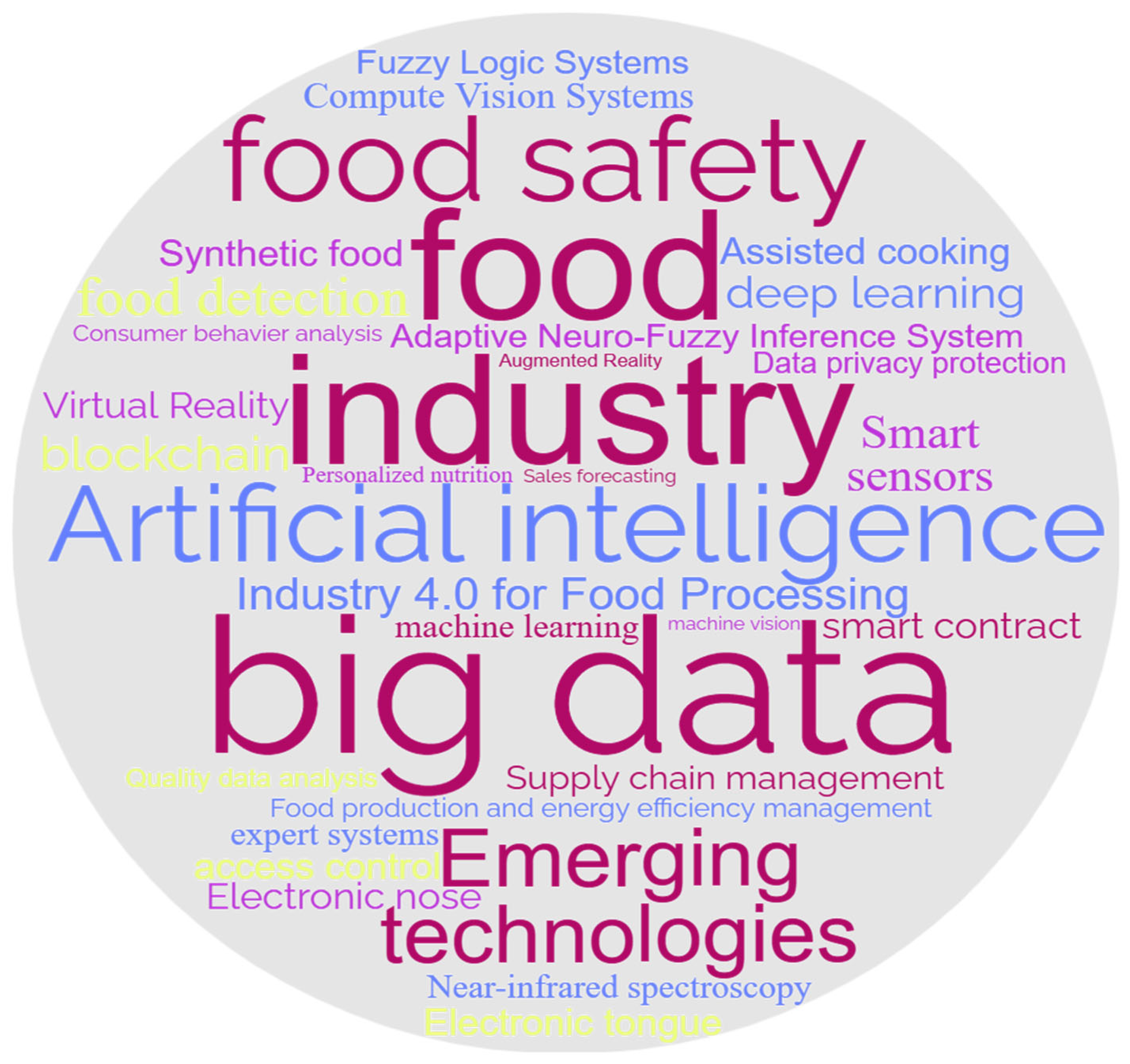
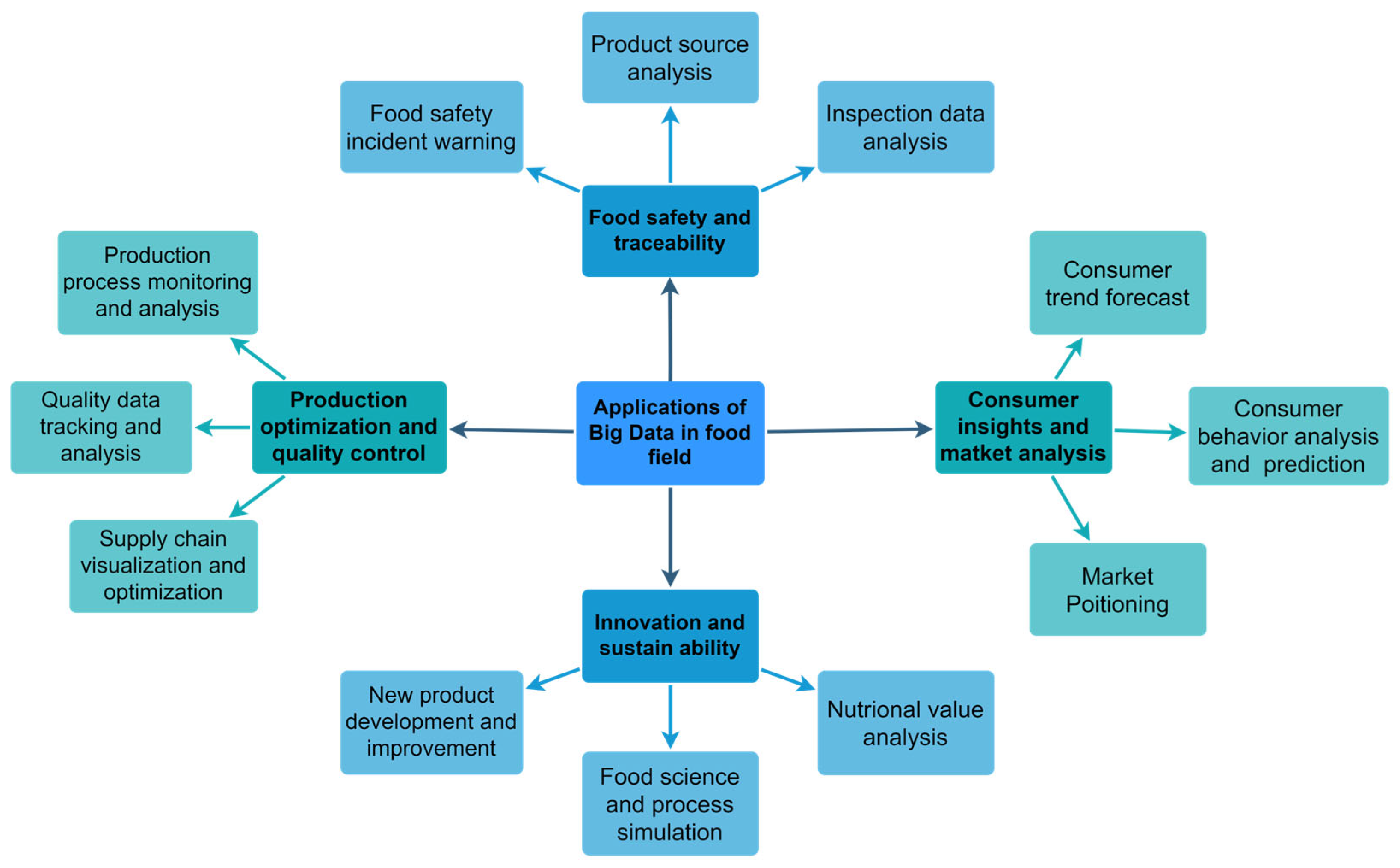
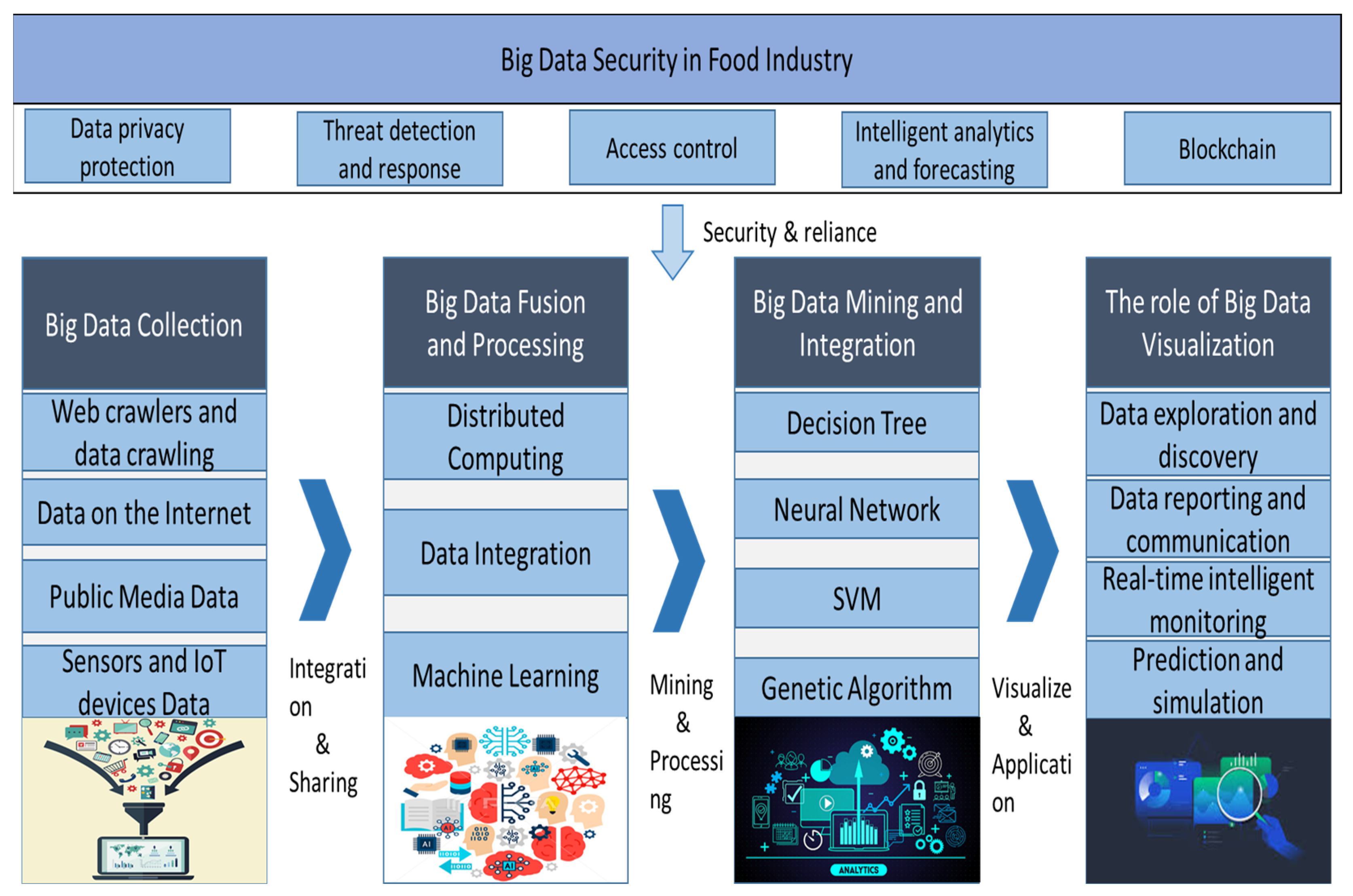
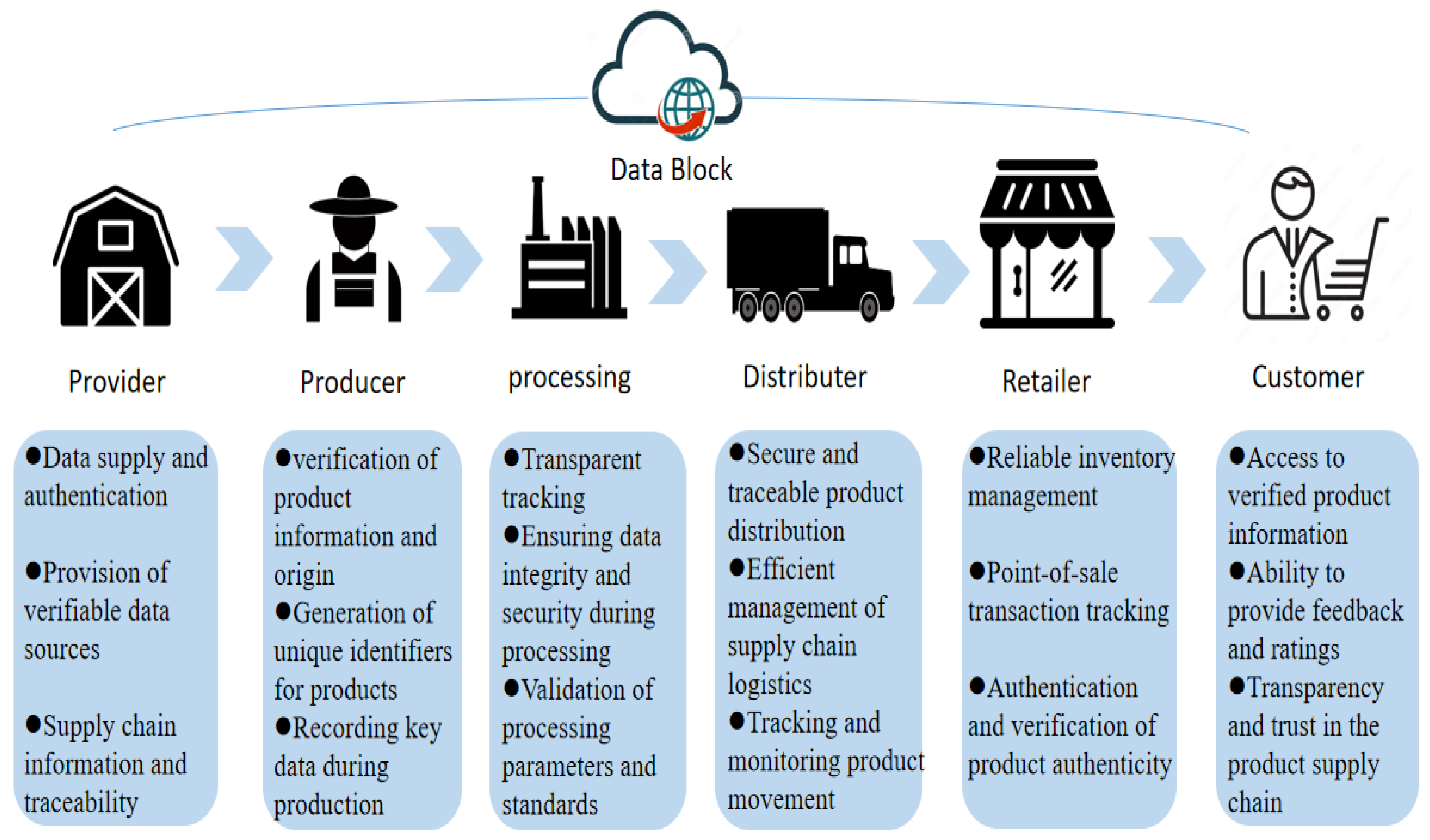

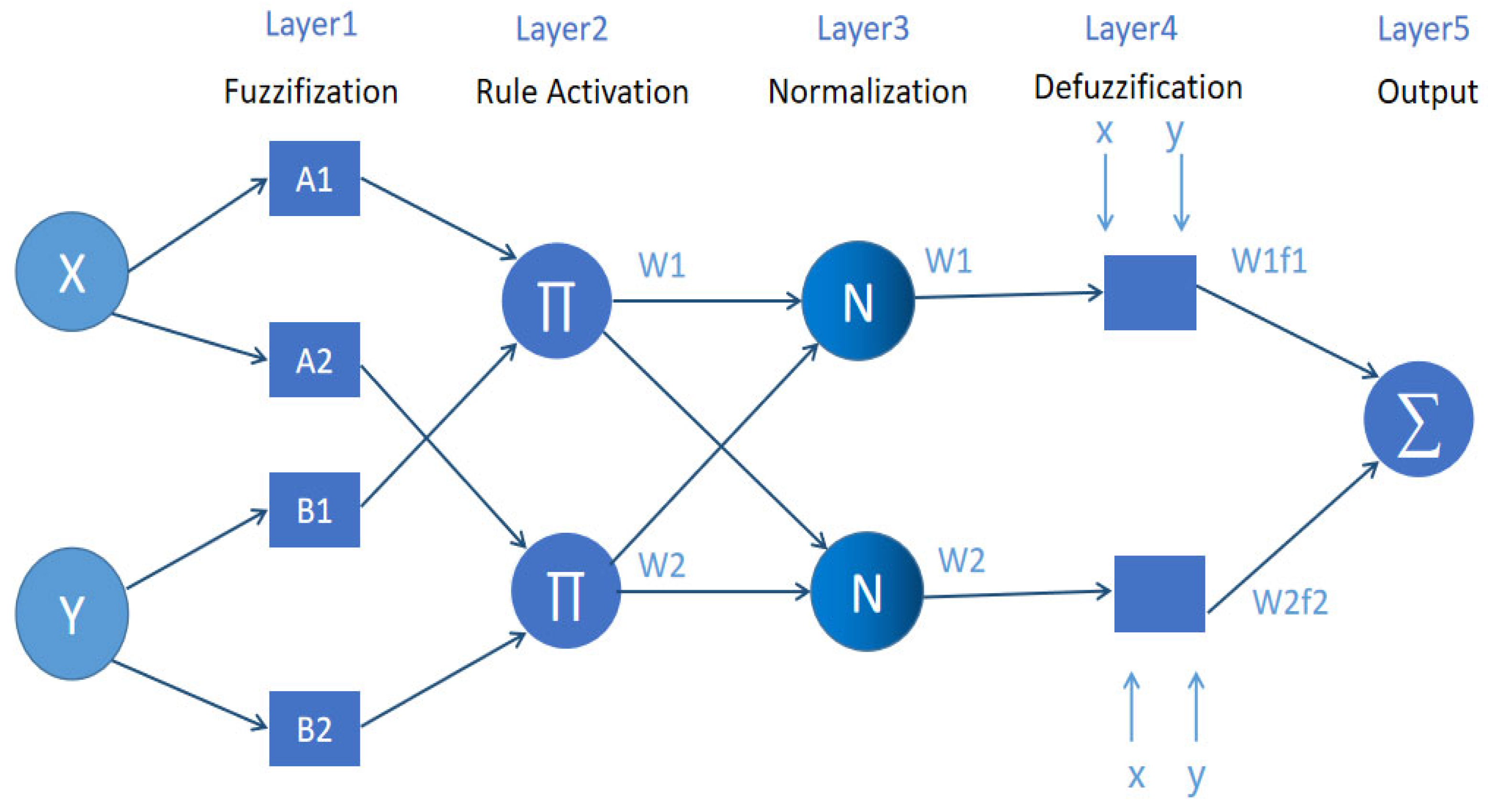

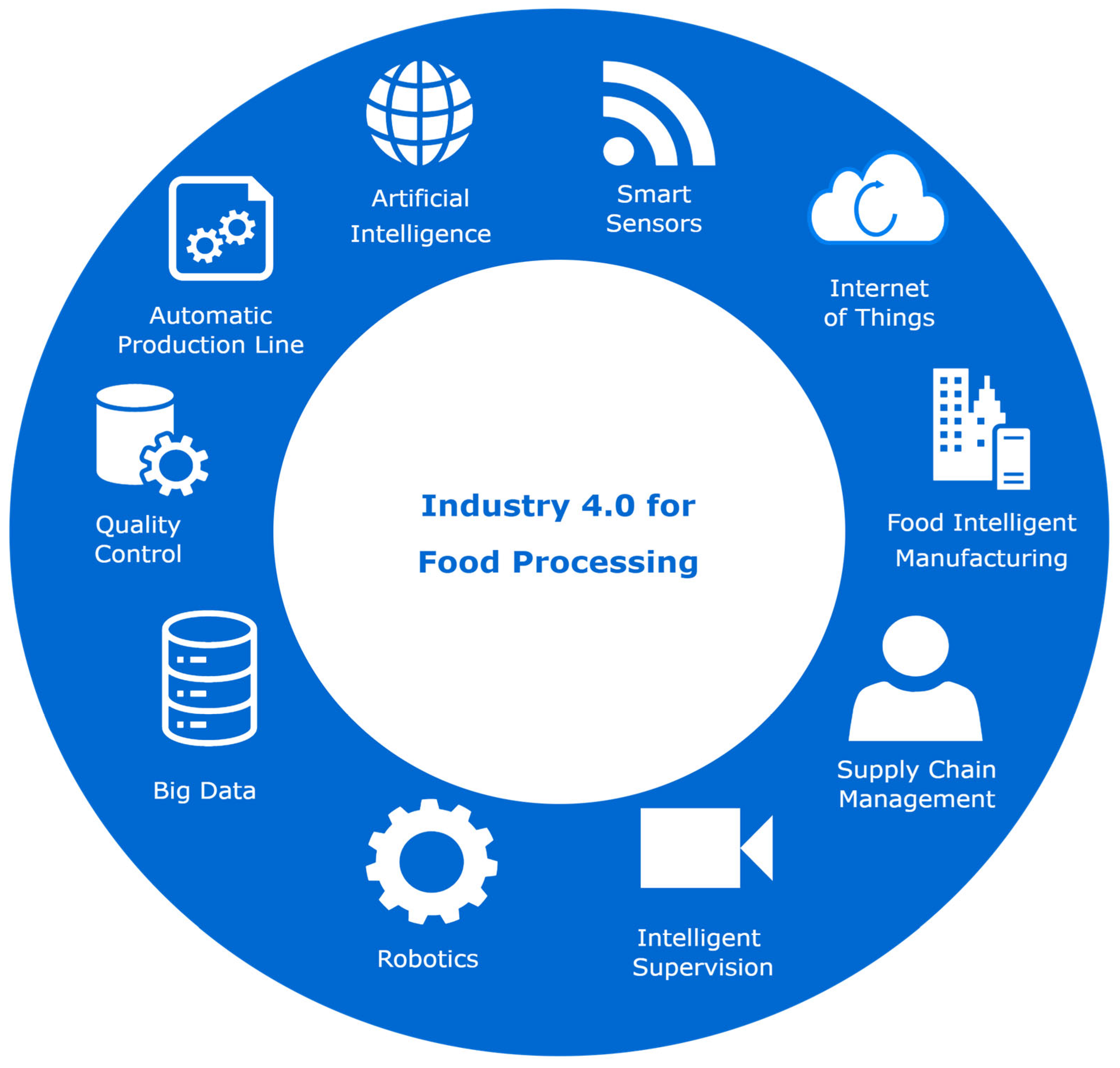
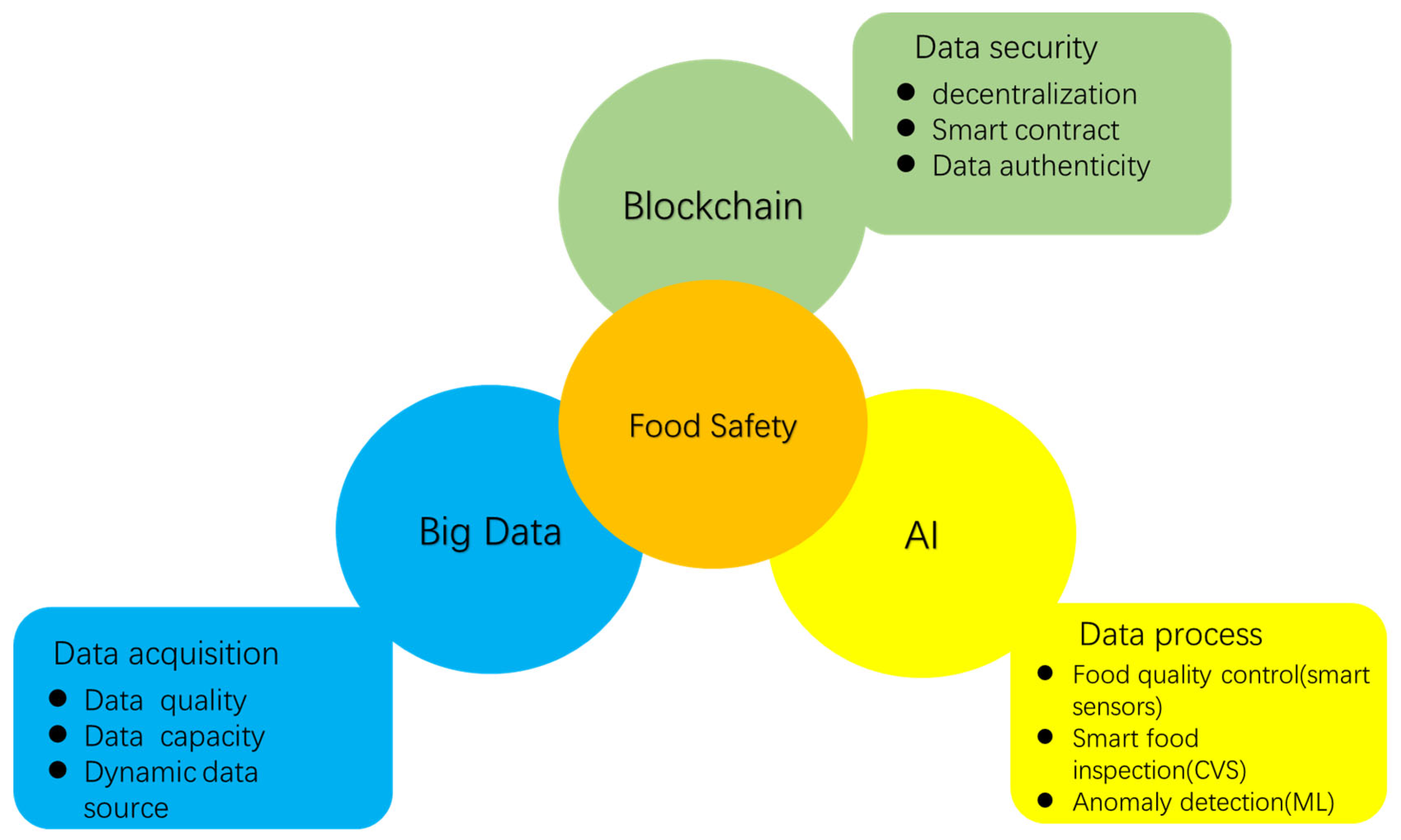
| Products | Objectives | Projects/Companies Involved |
|---|---|---|
| Beer | Tracking the entire production process of beer to reveal its relevant ingredients. (Downstream is the first company to apply blockchain technology to beer.) | Downstream Brewing Company [79] |
| Beef | Implement blockchain technology to detect its supply chain process and prevent food fraud. | BeefLedger Corporation [80] |
| Grain | Identify the entire supply chain. | Agri-Digital [81] |
| Mango | Guarantee the traceability of the mango production chain. | IBM, Wal-Mart, Nestle, etc. [82] |
| High fructose corn syrup | Supervision and management. | The Coca-Cola Company |
| Chicken | Ensure its traceability. | Gogochicken, OriginTrail Inc. [83] |
| Food waste | Monitoring and management, waste forecasting. | Plastic Bank, Agora Technology Labs |
| Rice | Supervision and to ensure the quality of rice during transportation. | “Agri-Food Blockchain” Project [13] |
| Milk | Traceability to prevent food fraud in the dairy production process. | “Agri-Food Blockchain” Project |
| Authors | Research Subjects | Expected Goals | Experimental Results |
|---|---|---|---|
| Arabameri et al. [112] | Olive Oil | Prediction of the quality of olive oil samples and determination of the influence of other factors | Highly accurate prediction of olive oil quality and successful prediction of the effects of time, temperature, and phenolics on its stability |
| Kaveh et al. [114] | Potatoes, garlic, and cantaloupe | Predicted moisture diffusion rate and energy consumption ratio | Successful use of the ANFIS model for accurate prediction of its water content |
| Mokarram et al. [115] | Orange | Predicting orange flavor | Successful use of the ANFIS model for accurate prediction of orange flavor |
| Abbaspour-Gilandeh et al. [113] | Quince | Prediction of kinetic energy and energy of quince under hot air drying | Accurate prediction of kinetic energy of quince using the ANFIS model and multiple linear regression |
| Kumar et al. [116] | Taro | Optimization of the extraction process of taro | Successful optimization of extraction process of taro bioactive compounds using response surface methodology and ANFIS |
| Ojediran JO et al. [117] | Yam | Predicting the drying characteristics of yam | Accurate prediction of drying characteristics of yam slices in convective hot air desiccant using ANFIS |
| Authors | Research Subjects | Objectives | Experimental Results |
|---|---|---|---|
| Lopes et al. [125] | Barley flour | Forecast for barley flour | Classification using spatial pyramid segmentation method, the final prediction with SVM is 95% |
| Siswantoro et al. [129] | Eggs | Predicting egg volume | Successfully predicted egg volume with ANN model with a 97.38% success rate |
| Villager-Aguilar et al. [128] | Sweet pepper | Predicting the ripening status of bell peppers | Successfully developed an artificial vision system using CVS and ANN/FL to predict the ripeness of bell peppers with a maximum accuracy of 88% for FL and 100% for ANN |
| Bakhshipour et al. [130] | Iranian black tea and green tea | Classification of black and green teas in Iran | Successful classification of both with REP decision trees |
| Mazen et al. [131] | Banana | Predicting the ripening of bananas | Successfully used SVM and ANN algorithms to accurately predict the ripening level of bananas with an accuracy of 98% |
| Wan et al. [132] | Tomato | Predicting the ripeness of fresh tomatoes | Accurate detection of tomato ripeness with ANN algorithm with 99% accuracy |
| Markande et al. [133] | Potatoes | Grade classification of potatoes | A combination of CVS technology and fuzzy logic system successfully classifies potatoes and reduces costs |
| Garcia et al. [134] | Vegetable seeds | Sorting vegetable seeds | Successful classification of spinach seeds and cabbage seeds with ANN technology |
| Ozkan et al. [135] | Dry beans | Classification of different types of dry bean seeds | Successful classification of dry bean seeds with SVM, DT, ANN, and KNN algorithms |
| Zareiforoush et al. [136] | Rice | Grading the quality of rice | Successfully developed a system to grade rice quality with 97% accuracy |
| Feature | Conventional Laboratory Instruments | Electronic Nose | Electronic Tongue | Computer Vision | Sensory Analysis |
|---|---|---|---|---|---|
| Fast detection | √ | √ | √ | √ | × |
| Low-cost analysis | √ | √ | √ | √ | × |
| Chemical free analysis | × | × | × | × | × |
| Objectivity | √ | √ | √ | √ | × |
| Non-destructive measurement | √ | √ | × | √ | √ |
| Sample pre-treatment | × | × | √ | × | × |
| simple | √ | √ | √ | √ | × |
| Single operator | √ | √ | √ | √ | × |
| Permanent data storage | √ | √ | √ | √ | √ |
Disclaimer/Publisher’s Note: The statements, opinions and data contained in all publications are solely those of the individual author(s) and contributor(s) and not of MDPI and/or the editor(s). MDPI and/or the editor(s) disclaim responsibility for any injury to people or property resulting from any ideas, methods, instructions or products referred to in the content. |
© 2023 by the authors. Licensee MDPI, Basel, Switzerland. This article is an open access article distributed under the terms and conditions of the Creative Commons Attribution (CC BY) license (https://creativecommons.org/licenses/by/4.0/).
Share and Cite
Ding, H.; Tian, J.; Yu, W.; Wilson, D.I.; Young, B.R.; Cui, X.; Xin, X.; Wang, Z.; Li, W. The Application of Artificial Intelligence and Big Data in the Food Industry. Foods 2023, 12, 4511. https://doi.org/10.3390/foods12244511
Ding H, Tian J, Yu W, Wilson DI, Young BR, Cui X, Xin X, Wang Z, Li W. The Application of Artificial Intelligence and Big Data in the Food Industry. Foods. 2023; 12(24):4511. https://doi.org/10.3390/foods12244511
Chicago/Turabian StyleDing, Haohan, Jiawei Tian, Wei Yu, David I. Wilson, Brent R. Young, Xiaohui Cui, Xing Xin, Zhenyu Wang, and Wei Li. 2023. "The Application of Artificial Intelligence and Big Data in the Food Industry" Foods 12, no. 24: 4511. https://doi.org/10.3390/foods12244511





